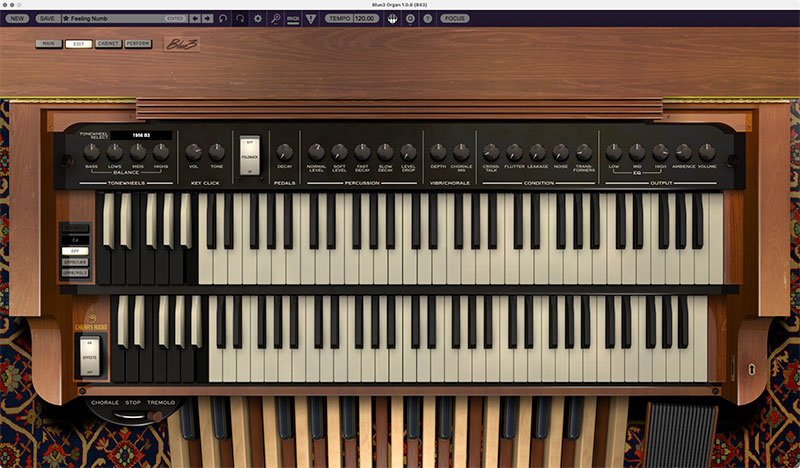
The EDIT page allows super-fine tweaking of almost every section of Blue3 for immense flexibility. To enter EDIT mode, simply click the EDIT button at the top left.
TONEWHEELS

Tonewheel Select- No two vintage tonewheel organs sound alike. They sound similar, but if you put any two organs side by side in a room, differences are noticeable. One of the main reasons for this are the tonewheels. Every tonewheel organ has 91 constantly spinning tonewheels that produce a somewhat pure tone and and every time a key is played, some combination of nine of them is heard, depending on the level of the drawbars. However, the output of the tone generators degrades over time, affected by aging capacitors among other things.
The Blue3 includes 31 sets of tonewheels measured from many actual tonewheel organs of varying age, model and condition, including B-3, C-3, M-3, A-100, L-100, and CV models. Each has their own special character. Sets marked as Wax tend to be older instruments that haven’t had their capacitors replaced, and tend to sound more mellow. The sets marked Recapped are either newer instruments or have had their capacitors replaced and therefore tend to sound brighter. If you’re looking for a softer sound, try one of the wax variations. If you’re looking for a screamer, choose one of the recapped or red mylar sets.
Tonewheel Balance- This adjusts the overall balance of sections of tonewheels, based on frequency. This is not the same as adjusting the EQ because each tonewheel is used in multiple key ranges. This adjusts the levels of the tonewheels smoothly in each range. Note that the Bass control only affects the Pedal manual.
KEY CLICK

When a key is pressed on a vintage tonewheel organ, nine separate key contacts close at slightly different times, making the connection to their respective tonewheels. Many factors go into the small noise or “click” that’s created when the key is closed such as dirt, velocity, tonewheel phase and more.
Volume - Nothing, a little or a lot.
Tone - Adjusts the overall brightness and character of the click. Clockwise is brighter, while counter-clockwise introduces more DC into the signal and therefore presents more of a low end thump.
FOLDBACK

16’ - On a B-3/C-3/A-100, the lowest octave for the 16’ drawbar repeats the octave above so as not to use the pedal tonewheels. Disabling Foldback make will make Blue3 sound more like an M- or L-series organ.
PEDALS
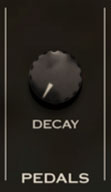
Decay - The length of time that it takes for the bass pedals to fade out. A normal tonewheel organ does not have this ability, but many players like this to simulate a walking bass style of playing. (The default value is off.)
PERCUSSION
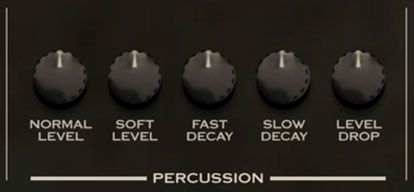
This allows the Percussion tonality to be tweaked to be a little louder or softer or faster or slower. These controls work in conjunction with the Percussion tab settings on the MAIN page.
Normal Level - Adjusts the volume of Percussion when the MAIN page Percussion Volume tab is set to Normal.
Soft Level - Adjusts the volume of Percussion when the MAIN page Percussion Volume tab is set to Soft.
Fast Decay - Adjusts the Percussion decay time when the MAIN page Percussion Decay tab is set to Fast.
Slow Decay - Adjusts the Percussion decay time when the MAIN page Percussion Decay tab is set to Slow.
Level Drop - Adjusts the amount the other tonewheels are lowered when i the MAIN page Percussion Volume tab is set to Normal.
VIBRATO and CHORALE
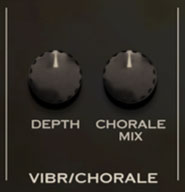
The Vibrato and Chorus in a vintage tonewheel organ is not like the vibrato or chorus effects in guitar amps or stomp boxes. Tonewheel organs included a unique and somewhat complex "scanner vibrato" circuit that's been super accurately simulated in Blue3.
Depth - How much the vibrato/chorus affects the sound.
Chorus Mix - How much of the non-vibrato sound is mixed with the vibrato sound in Chorus mode.
CONDITION
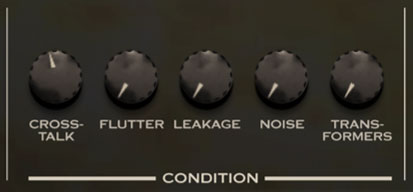
These controls allow adjustment of the age of the tonewheel organ simulation. These would be silent in an organ in absolutely pristine condition. Increasing the amount of these controls for a more authentically "aged" sounded organ.
Crosstalk - The amount of the neighboring tonewheels’ signal leaking into the proper tonewheels.
Flutter - Dirt and grime can make the driveshaft slightly out of round, contributing to a slight vibrato at different frequencies and levels throughout the instrument.
Leakage - The amount of tonewheels signal leaking through the drawbars when no notes are played.
Noise - Some power supply hum, amplifier hiss and rotary motor noise.
Transformers - The B3, C3, and A100 models each have two matching transformers where the drawbar outputs are mixed, one for the upper manual and one combined for the lower and pedal manuals. This control adds saturation/distortion and hysteresis to the signal for a bit of extra warmth.
OUTPUT
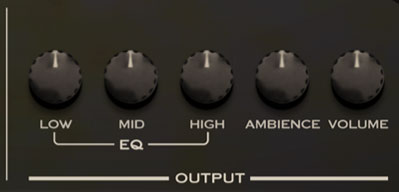
Ambience - Adds some room feel to the output. Not exactly a reverb, this simulates the energy of a live room.
EQ - Adjusts the lows, mids, and high frequencies of the entire instrument.
Volume - Final output volume.